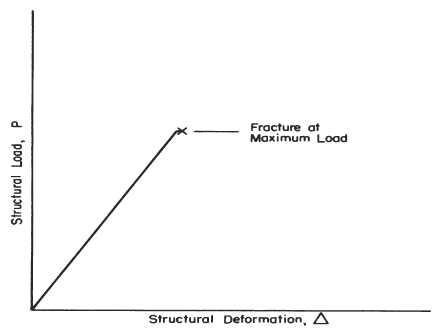Related Resources: material science
Brittle Fracture Analysis Calculator and Equation
Strength of Materials and Applications
Brittle Fracture Analysis Calculator and Equation
For materials that have little capacity for plastic flow, or for flaw and structural configurations, which induce triaxial tension stress states adjacent to the flaw, component behavior is essentially elastic until the fracture stress is reached. Then, a crack propagates from the flaw suddenly and completely through the component. A convenient illustration of brittle fracture is a typical load compliance record of a brittle structural component containing a flaw, as illustrated in Figure 1. Since little or no plastic effects are noted, this mode is termed brittle fracture.
This mode of fracture is characteristic of the very high-strength metallic materials under plane-strain conditions.

Figure1, Typical load deformation record
of a structural component containing a flaw
subject to brittle fracture.
The application of linear elastic fracture mechanics has led to the stress intensity concept to relate flaw size, component geometry, and fracture toughness. In its very general form, the stress-intensity factor, K, can be expressed as
where
f = stress applied to the gross section, ksi
a = measure of flaw size, inches
Y = factor-relating component geometry and flaw size, nondimensional. See
ASTM E 399 for values.
For every structural material that exhibits brittle fracture (by nature of low ductility or plane-strain stress conditions), there is a lower-limiting value of K termed the plane-strain fracture toughness, kic
The specific application of this relationship is dependent on flaw type, structural configuration, and type of loading, and a variety of these parameters can interact in a real structure. Flaws may occur through the thickness, may be imbedded as voids or metallurgical inclusions, or may be partial-through (surface) cracks. Loadings of concern may be tension and/or flexure. Structural components may vary in section size and may be reinforced in some manner. The ASTM Committee E 8 on Fatigue and Fracture has developed testing and analytical techniques for many practical situations of flaw occurrence subject to brittle fracture. They are summarized in ASTM E 399.
Reference:
Federal Avaition Administratation
Metallic Materials Properties
Development and Standardization
(MMPDS) Handbook
Related
- Fracture Mechanics for Structural Adhesive Bonds Fracture mechanics methodology was developed and experimentally demonstrated for the prediction of the growth of bondline flaws in an adhesively bonded
- Fatigue Failure
- Fatigue Crack Growth Analysis Review
- Linear Damage Rule - Miner's Rule
- Material Strength
- Malleability
- Poisson's Ratio Definition & Equation
- Poisson's Ratio Metals Materials Chart
- Von Mises Criterion ( Maximum Distortion Energy Criterion )
- Maximum Shear Stress Theory Fatigue of a Shaft or Axle Formula and Calculator
- Fatigue Design Curves and Analysis for Aluminum
- Local Stress-Strain Fatigue Method ( ε-N ) Although most engineering structures and machine components are designed such that the nominal stress remains elastic (S n < σ ys ) stress concentrations often cause plastic strains to develop in the vicinity of notches where the stress is elevated due to the stress concentration effect.
- Method of Virtual Mean Stress Fatigue Curve Equation
- Bagci Method Fatigue Curve Equation
- Structural Beam Stress and Deflection Calculations for Non-Engineers
- Ultimate Strength Design Method